Organizational Change and Leadership: Unit 17 Report, BAE Systems
VerifiedAdded on 2022/12/13
|19
|6464
|187
Report
AI Summary
This report provides a comprehensive analysis of organizational change within BAE Systems. It begins with an introduction outlining the necessity of change for business competitiveness and growth, followed by a comparison of BAE Systems with its competitor, Lockheed Martin, focusing on structural, marketing, HR, technology, and production changes. The report then delves into the drivers of organizational change, both internal (SWOT analysis) and external (political, economic, and social factors). It explores the effects of these drivers on leadership, teams, and individuals, along with measures to minimize the negative impacts of change. The analysis extends to the impact of barriers to change on decision-making, the influence of driving and restraining forces, and the application of force field analysis. Finally, the report examines various leadership approaches to manage change, assessing their effectiveness and providing recommendations for successful implementation, concluding with insights on market penetration strategies, operational management, and technological innovation.
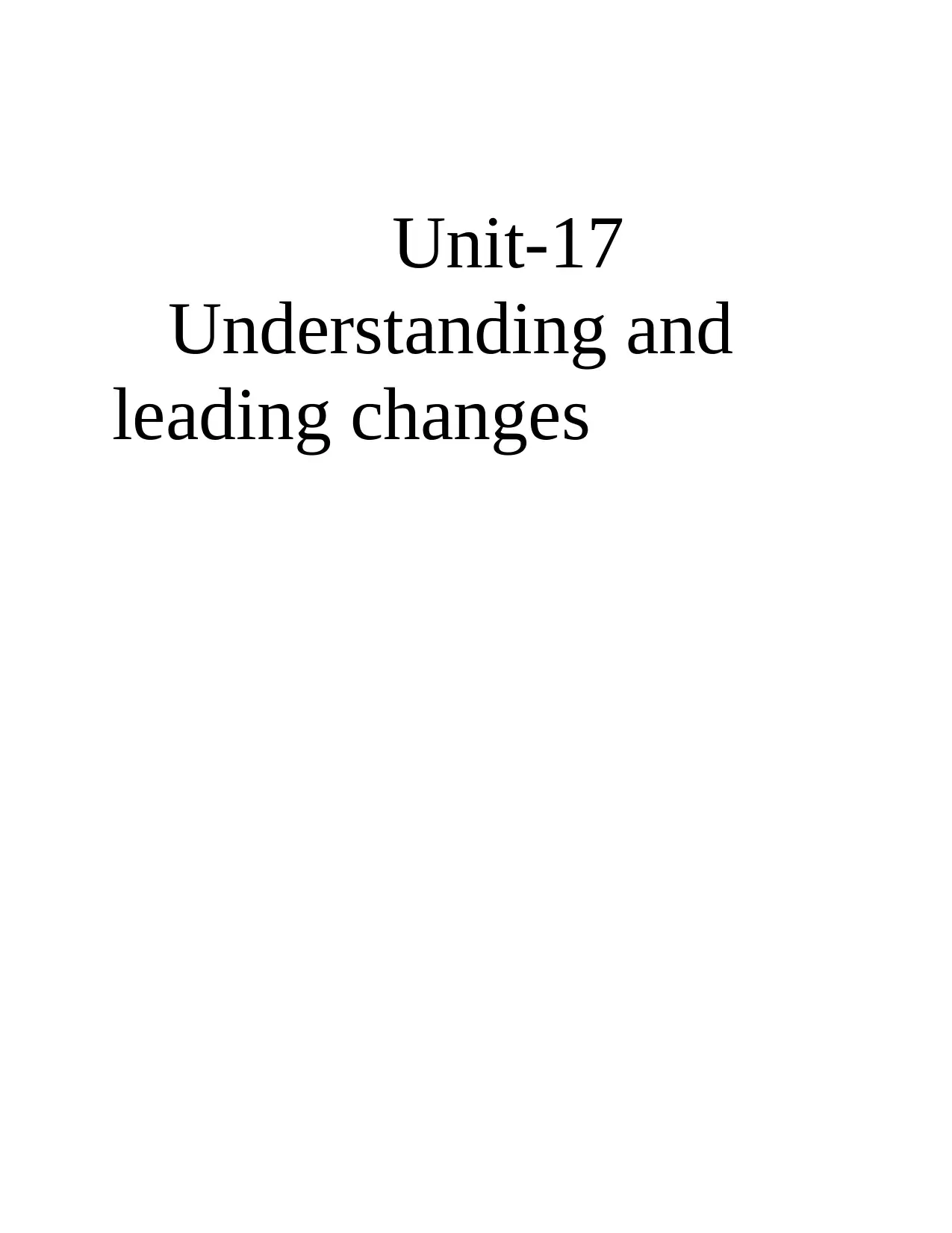
Unit-17
Understanding and
leading changes
Understanding and
leading changes
Paraphrase This Document
Need a fresh take? Get an instant paraphrase of this document with our AI Paraphraser
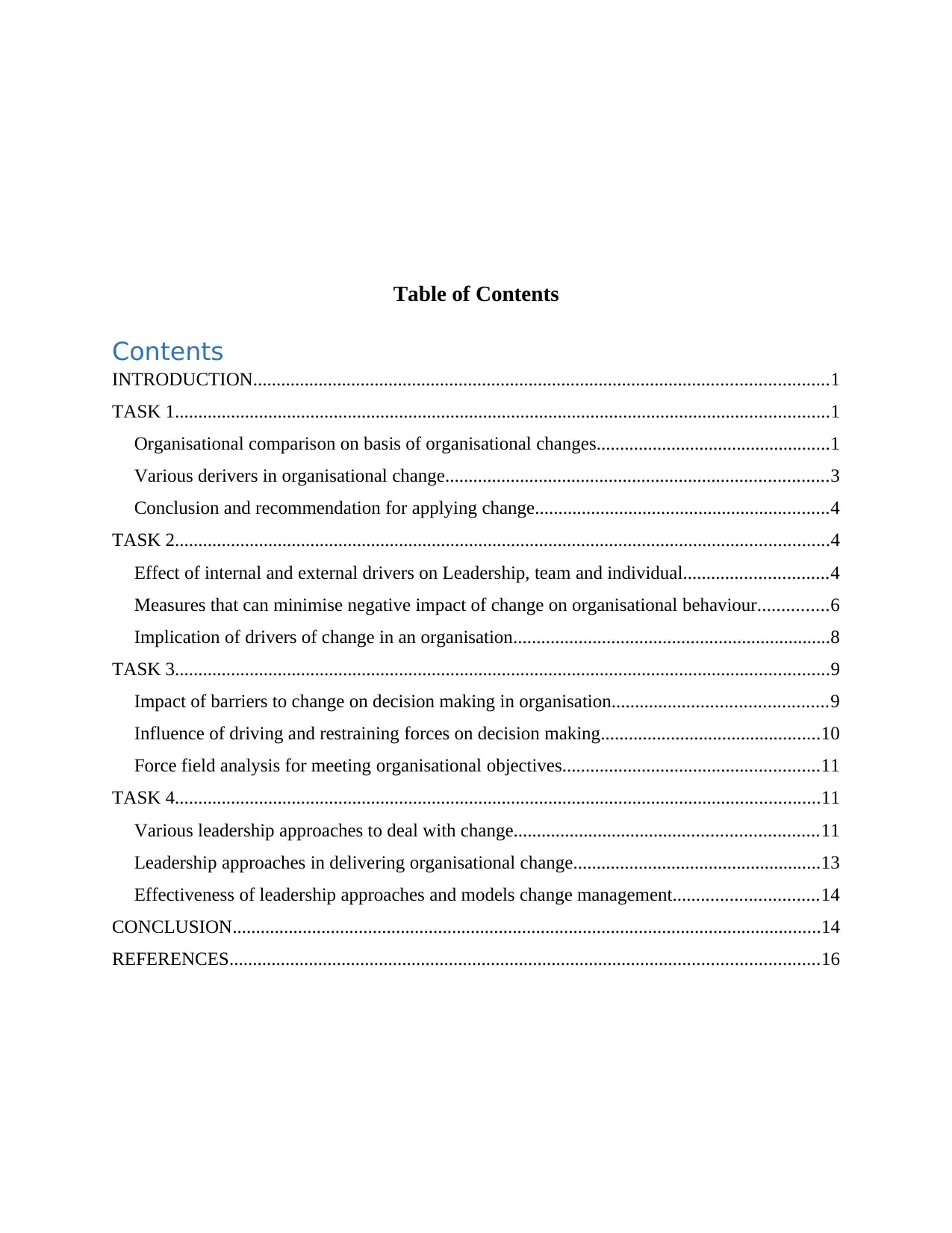
Table of Contents
Contents
INTRODUCTION...........................................................................................................................1
TASK 1............................................................................................................................................1
Organisational comparison on basis of organisational changes..................................................1
Various derivers in organisational change..................................................................................3
Conclusion and recommendation for applying change...............................................................4
TASK 2............................................................................................................................................4
Effect of internal and external drivers on Leadership, team and individual...............................4
Measures that can minimise negative impact of change on organisational behaviour...............6
Implication of drivers of change in an organisation....................................................................8
TASK 3............................................................................................................................................9
Impact of barriers to change on decision making in organisation..............................................9
Influence of driving and restraining forces on decision making...............................................10
Force field analysis for meeting organisational objectives.......................................................11
TASK 4..........................................................................................................................................11
Various leadership approaches to deal with change.................................................................11
Leadership approaches in delivering organisational change.....................................................13
Effectiveness of leadership approaches and models change management...............................14
CONCLUSION..............................................................................................................................14
REFERENCES..............................................................................................................................16
Contents
INTRODUCTION...........................................................................................................................1
TASK 1............................................................................................................................................1
Organisational comparison on basis of organisational changes..................................................1
Various derivers in organisational change..................................................................................3
Conclusion and recommendation for applying change...............................................................4
TASK 2............................................................................................................................................4
Effect of internal and external drivers on Leadership, team and individual...............................4
Measures that can minimise negative impact of change on organisational behaviour...............6
Implication of drivers of change in an organisation....................................................................8
TASK 3............................................................................................................................................9
Impact of barriers to change on decision making in organisation..............................................9
Influence of driving and restraining forces on decision making...............................................10
Force field analysis for meeting organisational objectives.......................................................11
TASK 4..........................................................................................................................................11
Various leadership approaches to deal with change.................................................................11
Leadership approaches in delivering organisational change.....................................................13
Effectiveness of leadership approaches and models change management...............................14
CONCLUSION..............................................................................................................................14
REFERENCES..............................................................................................................................16
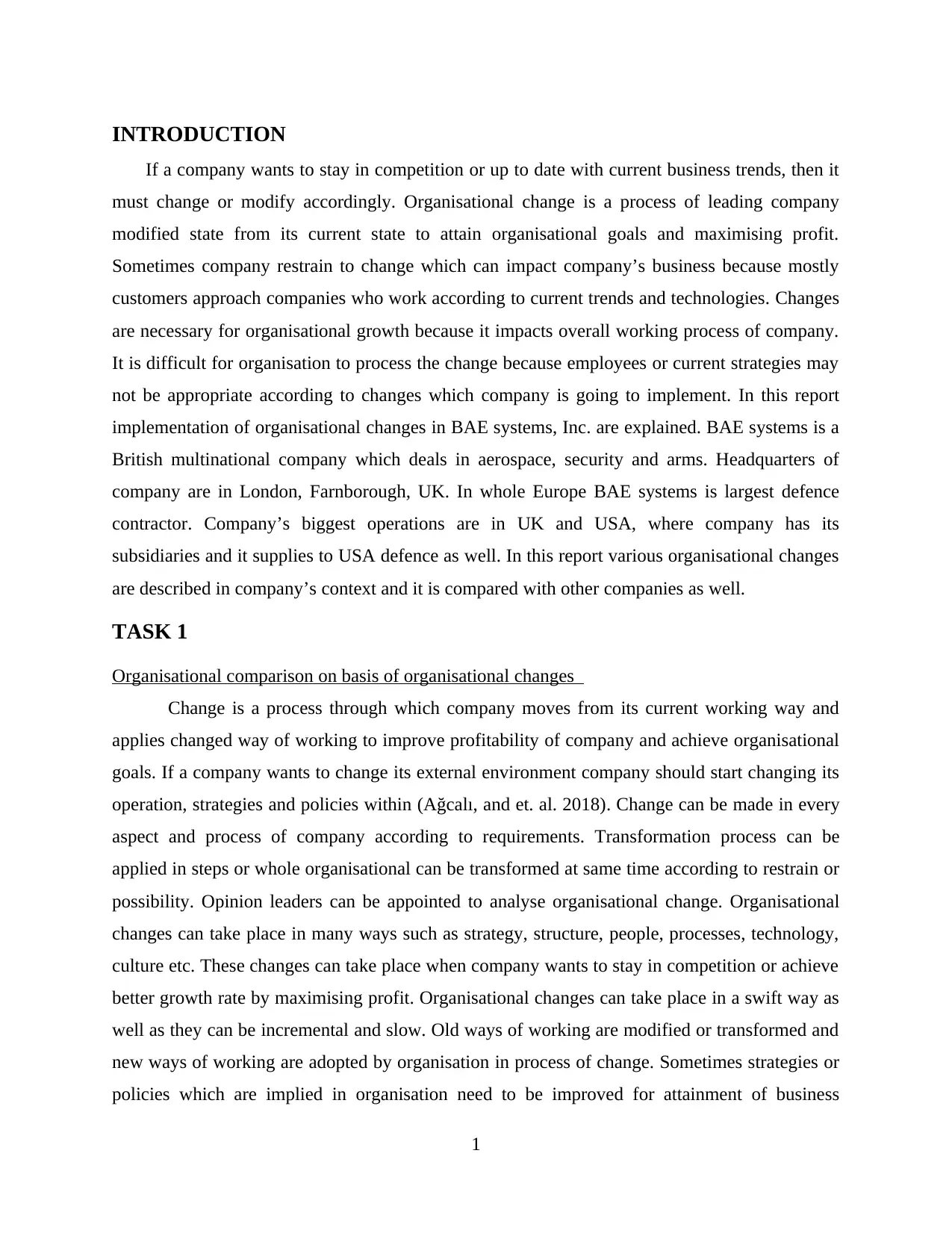
INTRODUCTION
If a company wants to stay in competition or up to date with current business trends, then it
must change or modify accordingly. Organisational change is a process of leading company
modified state from its current state to attain organisational goals and maximising profit.
Sometimes company restrain to change which can impact company’s business because mostly
customers approach companies who work according to current trends and technologies. Changes
are necessary for organisational growth because it impacts overall working process of company.
It is difficult for organisation to process the change because employees or current strategies may
not be appropriate according to changes which company is going to implement. In this report
implementation of organisational changes in BAE systems, Inc. are explained. BAE systems is a
British multinational company which deals in aerospace, security and arms. Headquarters of
company are in London, Farnborough, UK. In whole Europe BAE systems is largest defence
contractor. Company’s biggest operations are in UK and USA, where company has its
subsidiaries and it supplies to USA defence as well. In this report various organisational changes
are described in company’s context and it is compared with other companies as well.
TASK 1
Organisational comparison on basis of organisational changes
Change is a process through which company moves from its current working way and
applies changed way of working to improve profitability of company and achieve organisational
goals. If a company wants to change its external environment company should start changing its
operation, strategies and policies within (Ağcalı, and et. al. 2018) . Change can be made in every
aspect and process of company according to requirements. Transformation process can be
applied in steps or whole organisational can be transformed at same time according to restrain or
possibility. Opinion leaders can be appointed to analyse organisational change. Organisational
changes can take place in many ways such as strategy, structure, people, processes, technology,
culture etc. These changes can take place when company wants to stay in competition or achieve
better growth rate by maximising profit. Organisational changes can take place in a swift way as
well as they can be incremental and slow. Old ways of working are modified or transformed and
new ways of working are adopted by organisation in process of change. Sometimes strategies or
policies which are implied in organisation need to be improved for attainment of business
1
If a company wants to stay in competition or up to date with current business trends, then it
must change or modify accordingly. Organisational change is a process of leading company
modified state from its current state to attain organisational goals and maximising profit.
Sometimes company restrain to change which can impact company’s business because mostly
customers approach companies who work according to current trends and technologies. Changes
are necessary for organisational growth because it impacts overall working process of company.
It is difficult for organisation to process the change because employees or current strategies may
not be appropriate according to changes which company is going to implement. In this report
implementation of organisational changes in BAE systems, Inc. are explained. BAE systems is a
British multinational company which deals in aerospace, security and arms. Headquarters of
company are in London, Farnborough, UK. In whole Europe BAE systems is largest defence
contractor. Company’s biggest operations are in UK and USA, where company has its
subsidiaries and it supplies to USA defence as well. In this report various organisational changes
are described in company’s context and it is compared with other companies as well.
TASK 1
Organisational comparison on basis of organisational changes
Change is a process through which company moves from its current working way and
applies changed way of working to improve profitability of company and achieve organisational
goals. If a company wants to change its external environment company should start changing its
operation, strategies and policies within (Ağcalı, and et. al. 2018) . Change can be made in every
aspect and process of company according to requirements. Transformation process can be
applied in steps or whole organisational can be transformed at same time according to restrain or
possibility. Opinion leaders can be appointed to analyse organisational change. Organisational
changes can take place in many ways such as strategy, structure, people, processes, technology,
culture etc. These changes can take place when company wants to stay in competition or achieve
better growth rate by maximising profit. Organisational changes can take place in a swift way as
well as they can be incremental and slow. Old ways of working are modified or transformed and
new ways of working are adopted by organisation in process of change. Sometimes strategies or
policies which are implied in organisation need to be improved for attainment of business
1
⊘ This is a preview!⊘
Do you want full access?
Subscribe today to unlock all pages.

Trusted by 1+ million students worldwide
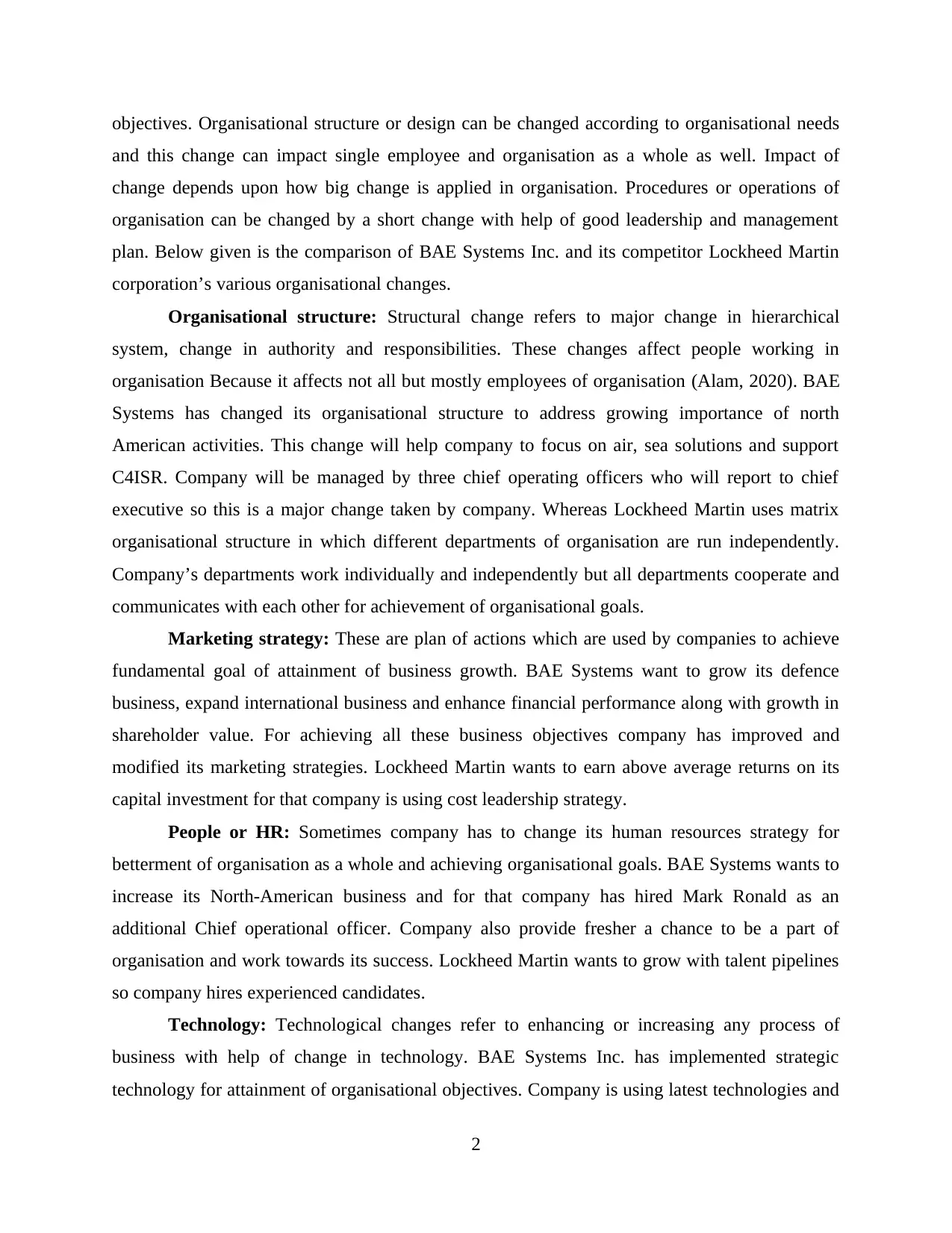
objectives. Organisational structure or design can be changed according to organisational needs
and this change can impact single employee and organisation as a whole as well. Impact of
change depends upon how big change is applied in organisation. Procedures or operations of
organisation can be changed by a short change with help of good leadership and management
plan. Below given is the comparison of BAE Systems Inc. and its competitor Lockheed Martin
corporation’s various organisational changes.
Organisational structure: Structural change refers to major change in hierarchical
system, change in authority and responsibilities. These changes affect people working in
organisation Because it affects not all but mostly employees of organisation (Alam, 2020). BAE
Systems has changed its organisational structure to address growing importance of north
American activities. This change will help company to focus on air, sea solutions and support
C4ISR. Company will be managed by three chief operating officers who will report to chief
executive so this is a major change taken by company. Whereas Lockheed Martin uses matrix
organisational structure in which different departments of organisation are run independently.
Company’s departments work individually and independently but all departments cooperate and
communicates with each other for achievement of organisational goals.
Marketing strategy: These are plan of actions which are used by companies to achieve
fundamental goal of attainment of business growth. BAE Systems want to grow its defence
business, expand international business and enhance financial performance along with growth in
shareholder value. For achieving all these business objectives company has improved and
modified its marketing strategies. Lockheed Martin wants to earn above average returns on its
capital investment for that company is using cost leadership strategy.
People or HR: Sometimes company has to change its human resources strategy for
betterment of organisation as a whole and achieving organisational goals. BAE Systems wants to
increase its North-American business and for that company has hired Mark Ronald as an
additional Chief operational officer. Company also provide fresher a chance to be a part of
organisation and work towards its success. Lockheed Martin wants to grow with talent pipelines
so company hires experienced candidates.
Technology: Technological changes refer to enhancing or increasing any process of
business with help of change in technology. BAE Systems Inc. has implemented strategic
technology for attainment of organisational objectives. Company is using latest technologies and
2
and this change can impact single employee and organisation as a whole as well. Impact of
change depends upon how big change is applied in organisation. Procedures or operations of
organisation can be changed by a short change with help of good leadership and management
plan. Below given is the comparison of BAE Systems Inc. and its competitor Lockheed Martin
corporation’s various organisational changes.
Organisational structure: Structural change refers to major change in hierarchical
system, change in authority and responsibilities. These changes affect people working in
organisation Because it affects not all but mostly employees of organisation (Alam, 2020). BAE
Systems has changed its organisational structure to address growing importance of north
American activities. This change will help company to focus on air, sea solutions and support
C4ISR. Company will be managed by three chief operating officers who will report to chief
executive so this is a major change taken by company. Whereas Lockheed Martin uses matrix
organisational structure in which different departments of organisation are run independently.
Company’s departments work individually and independently but all departments cooperate and
communicates with each other for achievement of organisational goals.
Marketing strategy: These are plan of actions which are used by companies to achieve
fundamental goal of attainment of business growth. BAE Systems want to grow its defence
business, expand international business and enhance financial performance along with growth in
shareholder value. For achieving all these business objectives company has improved and
modified its marketing strategies. Lockheed Martin wants to earn above average returns on its
capital investment for that company is using cost leadership strategy.
People or HR: Sometimes company has to change its human resources strategy for
betterment of organisation as a whole and achieving organisational goals. BAE Systems wants to
increase its North-American business and for that company has hired Mark Ronald as an
additional Chief operational officer. Company also provide fresher a chance to be a part of
organisation and work towards its success. Lockheed Martin wants to grow with talent pipelines
so company hires experienced candidates.
Technology: Technological changes refer to enhancing or increasing any process of
business with help of change in technology. BAE Systems Inc. has implemented strategic
technology for attainment of organisational objectives. Company is using latest technologies and
2
Paraphrase This Document
Need a fresh take? Get an instant paraphrase of this document with our AI Paraphraser
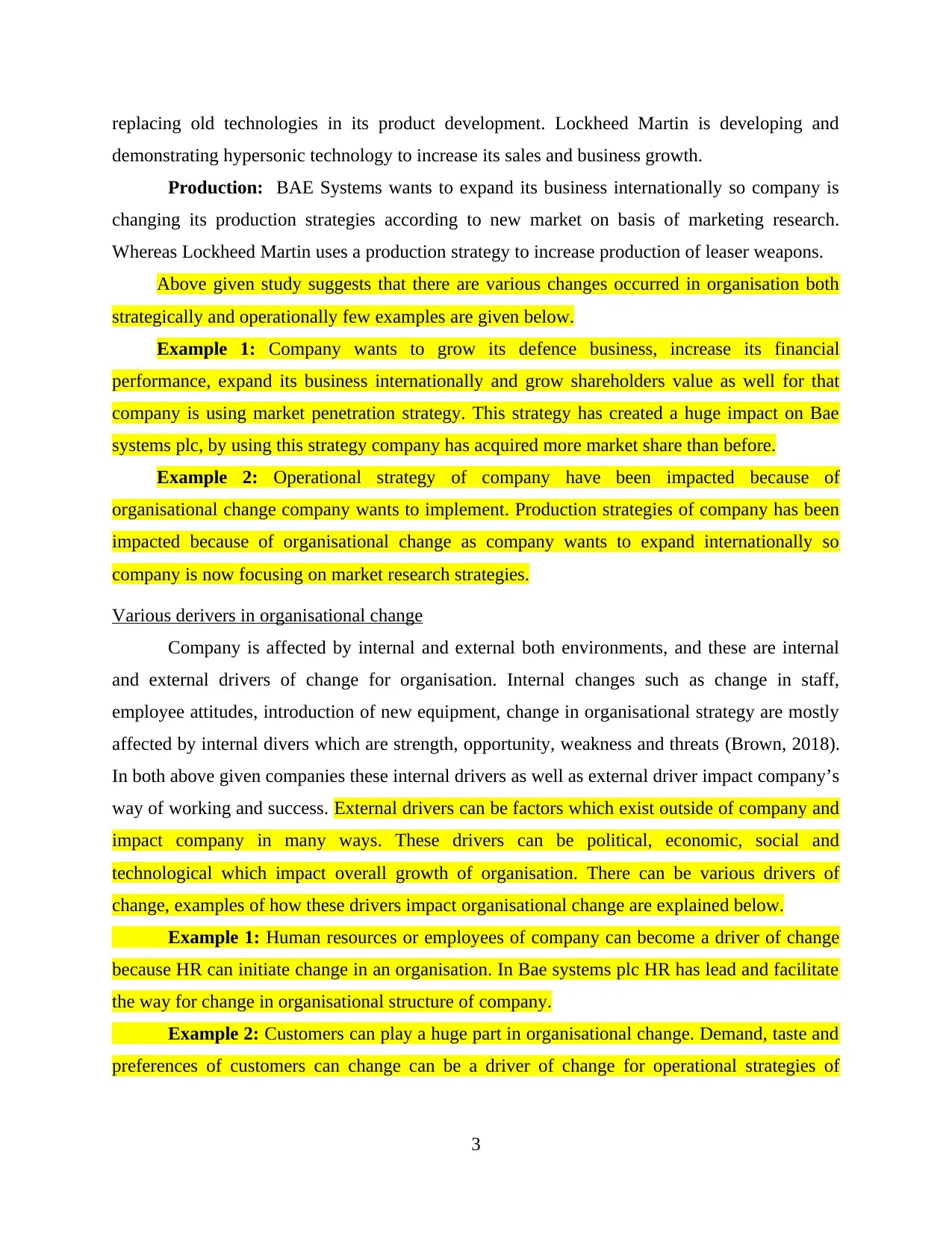
replacing old technologies in its product development. Lockheed Martin is developing and
demonstrating hypersonic technology to increase its sales and business growth.
Production: BAE Systems wants to expand its business internationally so company is
changing its production strategies according to new market on basis of marketing research.
Whereas Lockheed Martin uses a production strategy to increase production of leaser weapons.
Above given study suggests that there are various changes occurred in organisation both
strategically and operationally few examples are given below.
Example 1: Company wants to grow its defence business, increase its financial
performance, expand its business internationally and grow shareholders value as well for that
company is using market penetration strategy. This strategy has created a huge impact on Bae
systems plc, by using this strategy company has acquired more market share than before.
Example 2: Operational strategy of company have been impacted because of
organisational change company wants to implement. Production strategies of company has been
impacted because of organisational change as company wants to expand internationally so
company is now focusing on market research strategies.
Various derivers in organisational change
Company is affected by internal and external both environments, and these are internal
and external drivers of change for organisation. Internal changes such as change in staff,
employee attitudes, introduction of new equipment, change in organisational strategy are mostly
affected by internal divers which are strength, opportunity, weakness and threats (Brown, 2018).
In both above given companies these internal drivers as well as external driver impact company’s
way of working and success. External drivers can be factors which exist outside of company and
impact company in many ways. These drivers can be political, economic, social and
technological which impact overall growth of organisation. There can be various drivers of
change, examples of how these drivers impact organisational change are explained below.
Example 1: Human resources or employees of company can become a driver of change
because HR can initiate change in an organisation. In Bae systems plc HR has lead and facilitate
the way for change in organisational structure of company.
Example 2: Customers can play a huge part in organisational change. Demand, taste and
preferences of customers can change can be a driver of change for operational strategies of
3
demonstrating hypersonic technology to increase its sales and business growth.
Production: BAE Systems wants to expand its business internationally so company is
changing its production strategies according to new market on basis of marketing research.
Whereas Lockheed Martin uses a production strategy to increase production of leaser weapons.
Above given study suggests that there are various changes occurred in organisation both
strategically and operationally few examples are given below.
Example 1: Company wants to grow its defence business, increase its financial
performance, expand its business internationally and grow shareholders value as well for that
company is using market penetration strategy. This strategy has created a huge impact on Bae
systems plc, by using this strategy company has acquired more market share than before.
Example 2: Operational strategy of company have been impacted because of
organisational change company wants to implement. Production strategies of company has been
impacted because of organisational change as company wants to expand internationally so
company is now focusing on market research strategies.
Various derivers in organisational change
Company is affected by internal and external both environments, and these are internal
and external drivers of change for organisation. Internal changes such as change in staff,
employee attitudes, introduction of new equipment, change in organisational strategy are mostly
affected by internal divers which are strength, opportunity, weakness and threats (Brown, 2018).
In both above given companies these internal drivers as well as external driver impact company’s
way of working and success. External drivers can be factors which exist outside of company and
impact company in many ways. These drivers can be political, economic, social and
technological which impact overall growth of organisation. There can be various drivers of
change, examples of how these drivers impact organisational change are explained below.
Example 1: Human resources or employees of company can become a driver of change
because HR can initiate change in an organisation. In Bae systems plc HR has lead and facilitate
the way for change in organisational structure of company.
Example 2: Customers can play a huge part in organisational change. Demand, taste and
preferences of customers can change can be a driver of change for operational strategies of
3
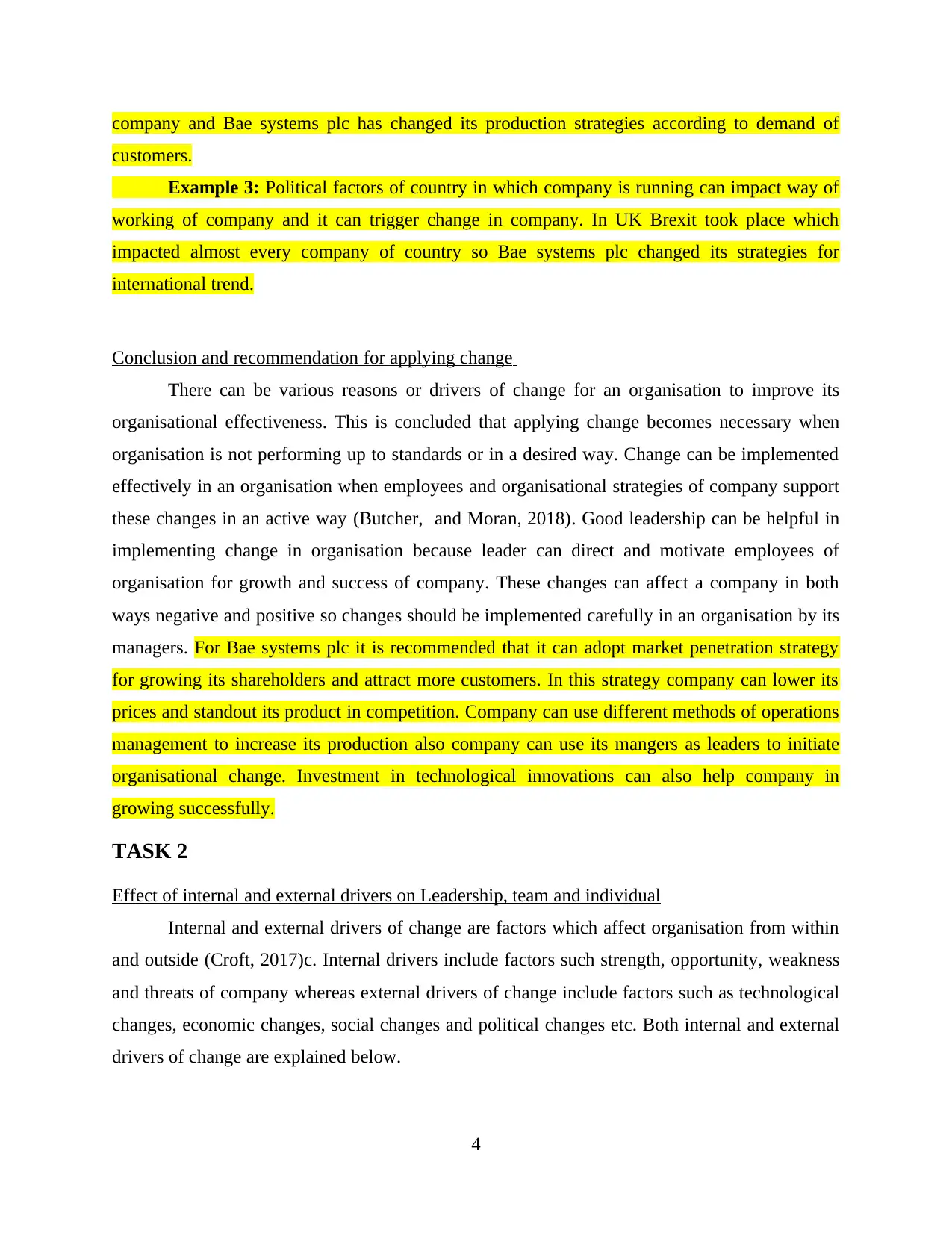
company and Bae systems plc has changed its production strategies according to demand of
customers.
Example 3: Political factors of country in which company is running can impact way of
working of company and it can trigger change in company. In UK Brexit took place which
impacted almost every company of country so Bae systems plc changed its strategies for
international trend.
Conclusion and recommendation for applying change
There can be various reasons or drivers of change for an organisation to improve its
organisational effectiveness. This is concluded that applying change becomes necessary when
organisation is not performing up to standards or in a desired way. Change can be implemented
effectively in an organisation when employees and organisational strategies of company support
these changes in an active way (Butcher, and Moran, 2018). Good leadership can be helpful in
implementing change in organisation because leader can direct and motivate employees of
organisation for growth and success of company. These changes can affect a company in both
ways negative and positive so changes should be implemented carefully in an organisation by its
managers. For Bae systems plc it is recommended that it can adopt market penetration strategy
for growing its shareholders and attract more customers. In this strategy company can lower its
prices and standout its product in competition. Company can use different methods of operations
management to increase its production also company can use its mangers as leaders to initiate
organisational change. Investment in technological innovations can also help company in
growing successfully.
TASK 2
Effect of internal and external drivers on Leadership, team and individual
Internal and external drivers of change are factors which affect organisation from within
and outside (Croft, 2017)c. Internal drivers include factors such strength, opportunity, weakness
and threats of company whereas external drivers of change include factors such as technological
changes, economic changes, social changes and political changes etc. Both internal and external
drivers of change are explained below.
4
customers.
Example 3: Political factors of country in which company is running can impact way of
working of company and it can trigger change in company. In UK Brexit took place which
impacted almost every company of country so Bae systems plc changed its strategies for
international trend.
Conclusion and recommendation for applying change
There can be various reasons or drivers of change for an organisation to improve its
organisational effectiveness. This is concluded that applying change becomes necessary when
organisation is not performing up to standards or in a desired way. Change can be implemented
effectively in an organisation when employees and organisational strategies of company support
these changes in an active way (Butcher, and Moran, 2018). Good leadership can be helpful in
implementing change in organisation because leader can direct and motivate employees of
organisation for growth and success of company. These changes can affect a company in both
ways negative and positive so changes should be implemented carefully in an organisation by its
managers. For Bae systems plc it is recommended that it can adopt market penetration strategy
for growing its shareholders and attract more customers. In this strategy company can lower its
prices and standout its product in competition. Company can use different methods of operations
management to increase its production also company can use its mangers as leaders to initiate
organisational change. Investment in technological innovations can also help company in
growing successfully.
TASK 2
Effect of internal and external drivers on Leadership, team and individual
Internal and external drivers of change are factors which affect organisation from within
and outside (Croft, 2017)c. Internal drivers include factors such strength, opportunity, weakness
and threats of company whereas external drivers of change include factors such as technological
changes, economic changes, social changes and political changes etc. Both internal and external
drivers of change are explained below.
4
⊘ This is a preview!⊘
Do you want full access?
Subscribe today to unlock all pages.

Trusted by 1+ million students worldwide
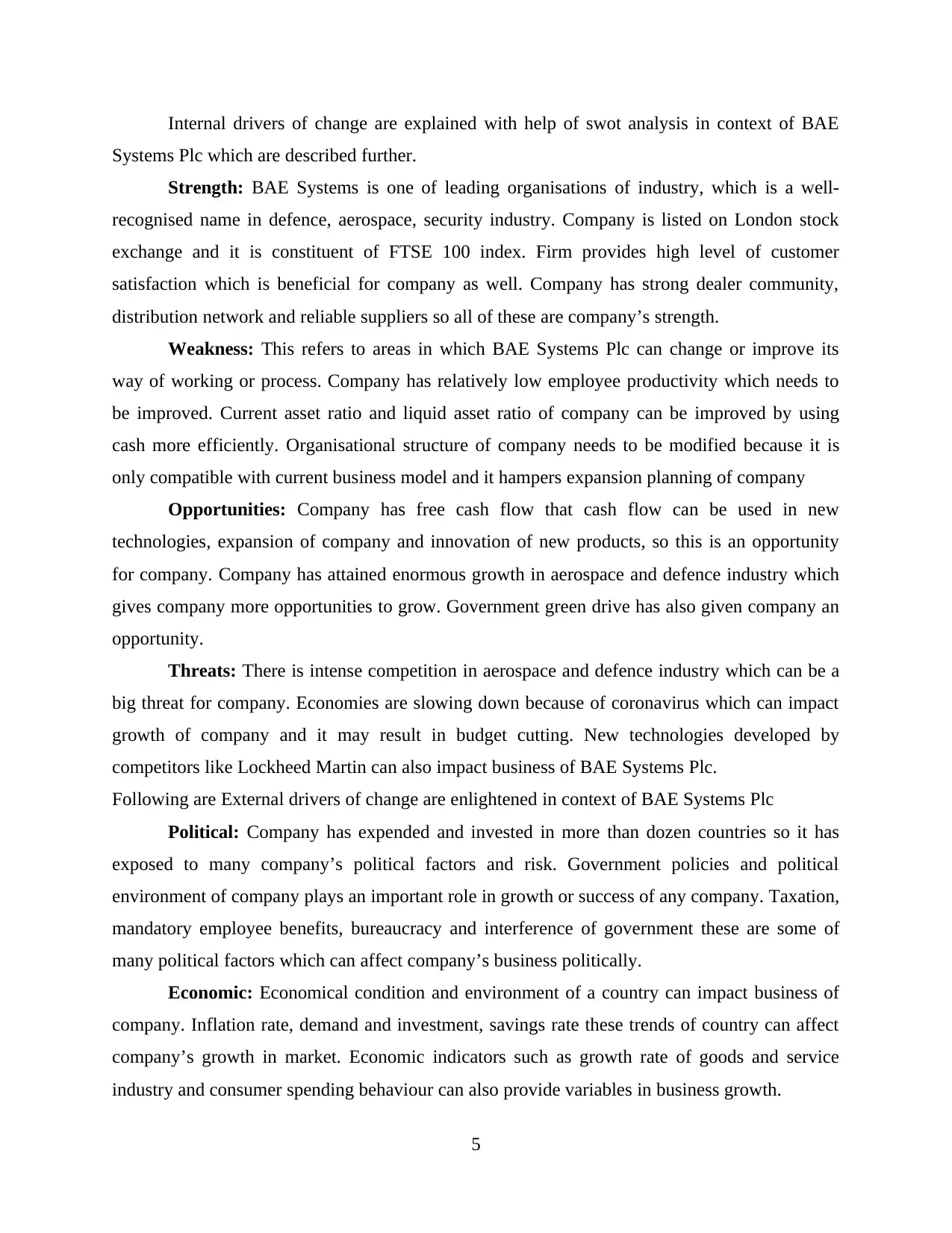
Internal drivers of change are explained with help of swot analysis in context of BAE
Systems Plc which are described further.
Strength: BAE Systems is one of leading organisations of industry, which is a well-
recognised name in defence, aerospace, security industry. Company is listed on London stock
exchange and it is constituent of FTSE 100 index. Firm provides high level of customer
satisfaction which is beneficial for company as well. Company has strong dealer community,
distribution network and reliable suppliers so all of these are company’s strength.
Weakness: This refers to areas in which BAE Systems Plc can change or improve its
way of working or process. Company has relatively low employee productivity which needs to
be improved. Current asset ratio and liquid asset ratio of company can be improved by using
cash more efficiently. Organisational structure of company needs to be modified because it is
only compatible with current business model and it hampers expansion planning of company
Opportunities: Company has free cash flow that cash flow can be used in new
technologies, expansion of company and innovation of new products, so this is an opportunity
for company. Company has attained enormous growth in aerospace and defence industry which
gives company more opportunities to grow. Government green drive has also given company an
opportunity.
Threats: There is intense competition in aerospace and defence industry which can be a
big threat for company. Economies are slowing down because of coronavirus which can impact
growth of company and it may result in budget cutting. New technologies developed by
competitors like Lockheed Martin can also impact business of BAE Systems Plc.
Following are External drivers of change are enlightened in context of BAE Systems Plc
Political: Company has expended and invested in more than dozen countries so it has
exposed to many company’s political factors and risk. Government policies and political
environment of company plays an important role in growth or success of any company. Taxation,
mandatory employee benefits, bureaucracy and interference of government these are some of
many political factors which can affect company’s business politically.
Economic: Economical condition and environment of a country can impact business of
company. Inflation rate, demand and investment, savings rate these trends of country can affect
company’s growth in market. Economic indicators such as growth rate of goods and service
industry and consumer spending behaviour can also provide variables in business growth.
5
Systems Plc which are described further.
Strength: BAE Systems is one of leading organisations of industry, which is a well-
recognised name in defence, aerospace, security industry. Company is listed on London stock
exchange and it is constituent of FTSE 100 index. Firm provides high level of customer
satisfaction which is beneficial for company as well. Company has strong dealer community,
distribution network and reliable suppliers so all of these are company’s strength.
Weakness: This refers to areas in which BAE Systems Plc can change or improve its
way of working or process. Company has relatively low employee productivity which needs to
be improved. Current asset ratio and liquid asset ratio of company can be improved by using
cash more efficiently. Organisational structure of company needs to be modified because it is
only compatible with current business model and it hampers expansion planning of company
Opportunities: Company has free cash flow that cash flow can be used in new
technologies, expansion of company and innovation of new products, so this is an opportunity
for company. Company has attained enormous growth in aerospace and defence industry which
gives company more opportunities to grow. Government green drive has also given company an
opportunity.
Threats: There is intense competition in aerospace and defence industry which can be a
big threat for company. Economies are slowing down because of coronavirus which can impact
growth of company and it may result in budget cutting. New technologies developed by
competitors like Lockheed Martin can also impact business of BAE Systems Plc.
Following are External drivers of change are enlightened in context of BAE Systems Plc
Political: Company has expended and invested in more than dozen countries so it has
exposed to many company’s political factors and risk. Government policies and political
environment of company plays an important role in growth or success of any company. Taxation,
mandatory employee benefits, bureaucracy and interference of government these are some of
many political factors which can affect company’s business politically.
Economic: Economical condition and environment of a country can impact business of
company. Inflation rate, demand and investment, savings rate these trends of country can affect
company’s growth in market. Economic indicators such as growth rate of goods and service
industry and consumer spending behaviour can also provide variables in business growth.
5
Paraphrase This Document
Need a fresh take? Get an instant paraphrase of this document with our AI Paraphraser
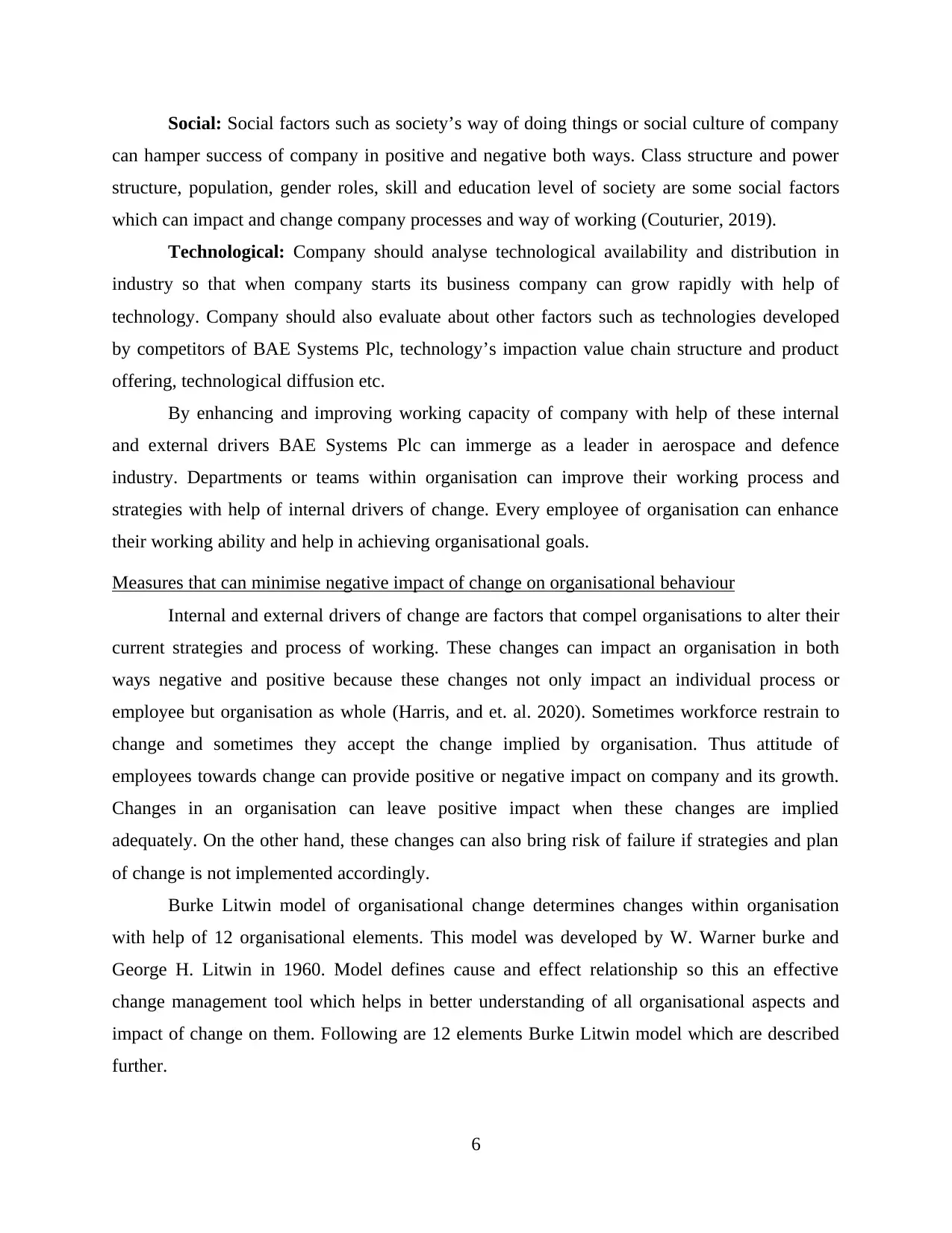
Social: Social factors such as society’s way of doing things or social culture of company
can hamper success of company in positive and negative both ways. Class structure and power
structure, population, gender roles, skill and education level of society are some social factors
which can impact and change company processes and way of working (Couturier, 2019).
Technological: Company should analyse technological availability and distribution in
industry so that when company starts its business company can grow rapidly with help of
technology. Company should also evaluate about other factors such as technologies developed
by competitors of BAE Systems Plc, technology’s impaction value chain structure and product
offering, technological diffusion etc.
By enhancing and improving working capacity of company with help of these internal
and external drivers BAE Systems Plc can immerge as a leader in aerospace and defence
industry. Departments or teams within organisation can improve their working process and
strategies with help of internal drivers of change. Every employee of organisation can enhance
their working ability and help in achieving organisational goals.
Measures that can minimise negative impact of change on organisational behaviour
Internal and external drivers of change are factors that compel organisations to alter their
current strategies and process of working. These changes can impact an organisation in both
ways negative and positive because these changes not only impact an individual process or
employee but organisation as whole (Harris, and et. al. 2020). Sometimes workforce restrain to
change and sometimes they accept the change implied by organisation. Thus attitude of
employees towards change can provide positive or negative impact on company and its growth.
Changes in an organisation can leave positive impact when these changes are implied
adequately. On the other hand, these changes can also bring risk of failure if strategies and plan
of change is not implemented accordingly.
Burke Litwin model of organisational change determines changes within organisation
with help of 12 organisational elements. This model was developed by W. Warner burke and
George H. Litwin in 1960. Model defines cause and effect relationship so this an effective
change management tool which helps in better understanding of all organisational aspects and
impact of change on them. Following are 12 elements Burke Litwin model which are described
further.
6
can hamper success of company in positive and negative both ways. Class structure and power
structure, population, gender roles, skill and education level of society are some social factors
which can impact and change company processes and way of working (Couturier, 2019).
Technological: Company should analyse technological availability and distribution in
industry so that when company starts its business company can grow rapidly with help of
technology. Company should also evaluate about other factors such as technologies developed
by competitors of BAE Systems Plc, technology’s impaction value chain structure and product
offering, technological diffusion etc.
By enhancing and improving working capacity of company with help of these internal
and external drivers BAE Systems Plc can immerge as a leader in aerospace and defence
industry. Departments or teams within organisation can improve their working process and
strategies with help of internal drivers of change. Every employee of organisation can enhance
their working ability and help in achieving organisational goals.
Measures that can minimise negative impact of change on organisational behaviour
Internal and external drivers of change are factors that compel organisations to alter their
current strategies and process of working. These changes can impact an organisation in both
ways negative and positive because these changes not only impact an individual process or
employee but organisation as whole (Harris, and et. al. 2020). Sometimes workforce restrain to
change and sometimes they accept the change implied by organisation. Thus attitude of
employees towards change can provide positive or negative impact on company and its growth.
Changes in an organisation can leave positive impact when these changes are implied
adequately. On the other hand, these changes can also bring risk of failure if strategies and plan
of change is not implemented accordingly.
Burke Litwin model of organisational change determines changes within organisation
with help of 12 organisational elements. This model was developed by W. Warner burke and
George H. Litwin in 1960. Model defines cause and effect relationship so this an effective
change management tool which helps in better understanding of all organisational aspects and
impact of change on them. Following are 12 elements Burke Litwin model which are described
further.
6
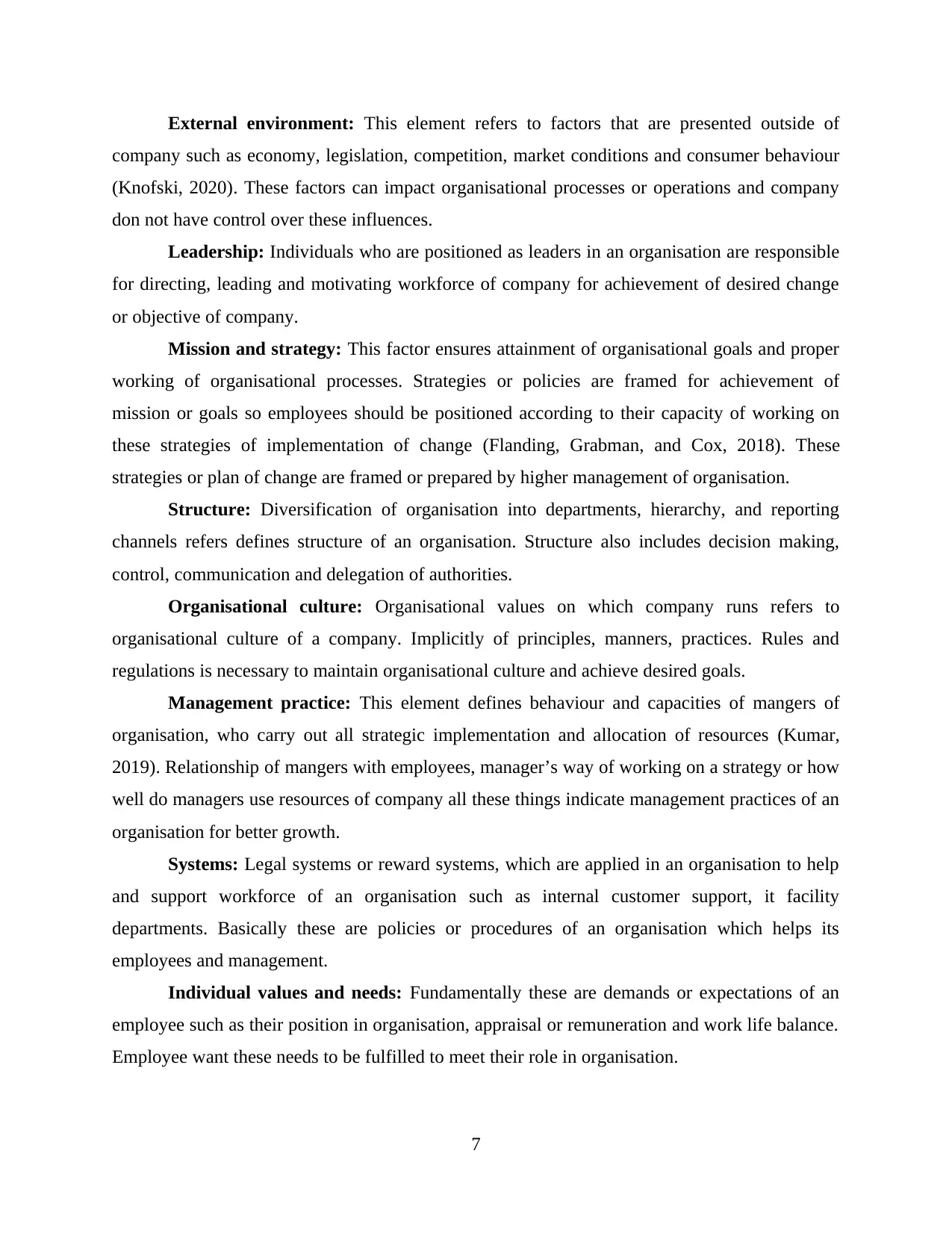
External environment: This element refers to factors that are presented outside of
company such as economy, legislation, competition, market conditions and consumer behaviour
(Knofski, 2020). These factors can impact organisational processes or operations and company
don not have control over these influences.
Leadership: Individuals who are positioned as leaders in an organisation are responsible
for directing, leading and motivating workforce of company for achievement of desired change
or objective of company.
Mission and strategy: This factor ensures attainment of organisational goals and proper
working of organisational processes. Strategies or policies are framed for achievement of
mission or goals so employees should be positioned according to their capacity of working on
these strategies of implementation of change (Flanding, Grabman, and Cox, 2018). These
strategies or plan of change are framed or prepared by higher management of organisation.
Structure: Diversification of organisation into departments, hierarchy, and reporting
channels refers defines structure of an organisation. Structure also includes decision making,
control, communication and delegation of authorities.
Organisational culture: Organisational values on which company runs refers to
organisational culture of a company. Implicitly of principles, manners, practices. Rules and
regulations is necessary to maintain organisational culture and achieve desired goals.
Management practice: This element defines behaviour and capacities of mangers of
organisation, who carry out all strategic implementation and allocation of resources (Kumar,
2019). Relationship of mangers with employees, manager’s way of working on a strategy or how
well do managers use resources of company all these things indicate management practices of an
organisation for better growth.
Systems: Legal systems or reward systems, which are applied in an organisation to help
and support workforce of an organisation such as internal customer support, it facility
departments. Basically these are policies or procedures of an organisation which helps its
employees and management.
Individual values and needs: Fundamentally these are demands or expectations of an
employee such as their position in organisation, appraisal or remuneration and work life balance.
Employee want these needs to be fulfilled to meet their role in organisation.
7
company such as economy, legislation, competition, market conditions and consumer behaviour
(Knofski, 2020). These factors can impact organisational processes or operations and company
don not have control over these influences.
Leadership: Individuals who are positioned as leaders in an organisation are responsible
for directing, leading and motivating workforce of company for achievement of desired change
or objective of company.
Mission and strategy: This factor ensures attainment of organisational goals and proper
working of organisational processes. Strategies or policies are framed for achievement of
mission or goals so employees should be positioned according to their capacity of working on
these strategies of implementation of change (Flanding, Grabman, and Cox, 2018). These
strategies or plan of change are framed or prepared by higher management of organisation.
Structure: Diversification of organisation into departments, hierarchy, and reporting
channels refers defines structure of an organisation. Structure also includes decision making,
control, communication and delegation of authorities.
Organisational culture: Organisational values on which company runs refers to
organisational culture of a company. Implicitly of principles, manners, practices. Rules and
regulations is necessary to maintain organisational culture and achieve desired goals.
Management practice: This element defines behaviour and capacities of mangers of
organisation, who carry out all strategic implementation and allocation of resources (Kumar,
2019). Relationship of mangers with employees, manager’s way of working on a strategy or how
well do managers use resources of company all these things indicate management practices of an
organisation for better growth.
Systems: Legal systems or reward systems, which are applied in an organisation to help
and support workforce of an organisation such as internal customer support, it facility
departments. Basically these are policies or procedures of an organisation which helps its
employees and management.
Individual values and needs: Fundamentally these are demands or expectations of an
employee such as their position in organisation, appraisal or remuneration and work life balance.
Employee want these needs to be fulfilled to meet their role in organisation.
7
⊘ This is a preview!⊘
Do you want full access?
Subscribe today to unlock all pages.

Trusted by 1+ million students worldwide
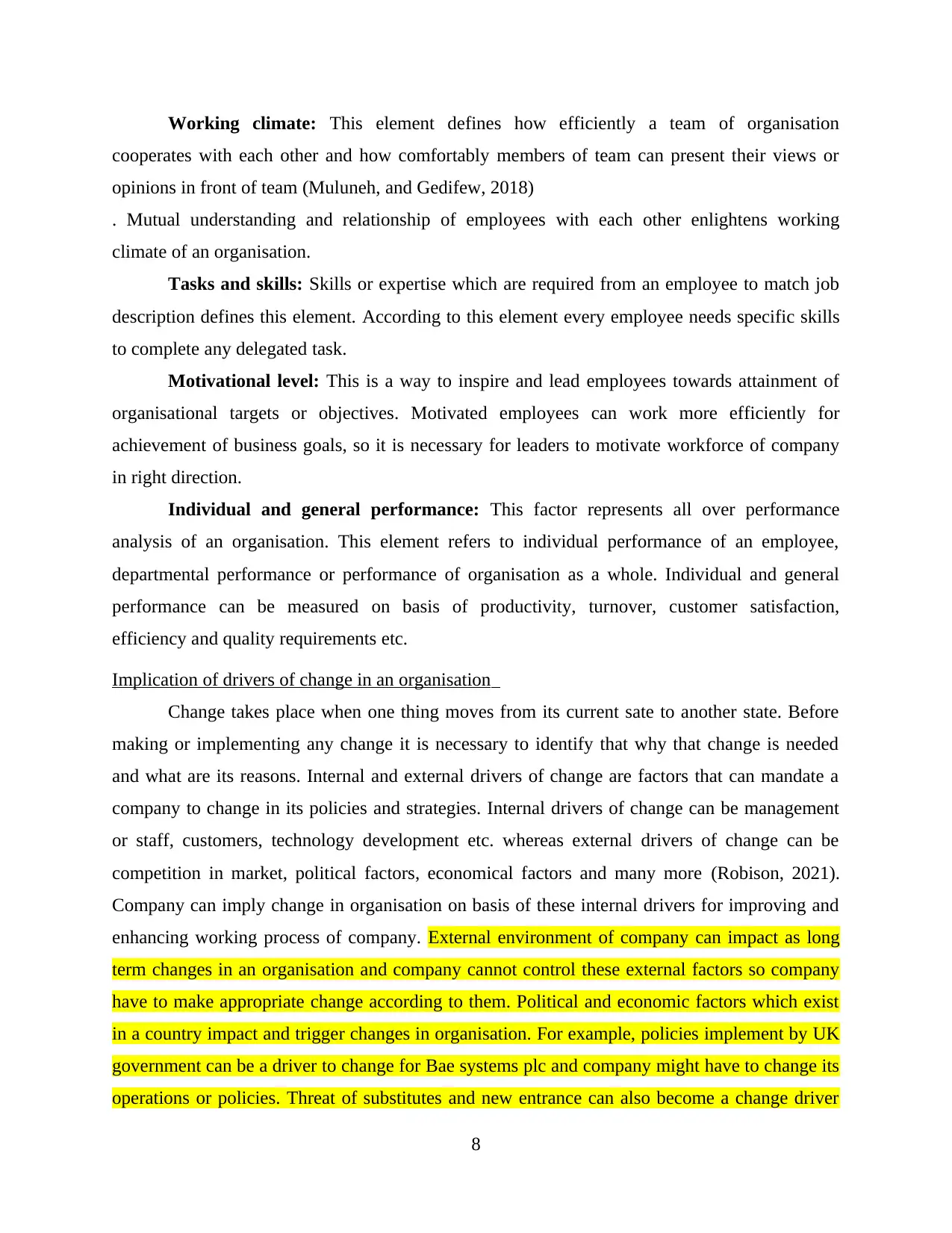
Working climate: This element defines how efficiently a team of organisation
cooperates with each other and how comfortably members of team can present their views or
opinions in front of team (Muluneh, and Gedifew, 2018)
. Mutual understanding and relationship of employees with each other enlightens working
climate of an organisation.
Tasks and skills: Skills or expertise which are required from an employee to match job
description defines this element. According to this element every employee needs specific skills
to complete any delegated task.
Motivational level: This is a way to inspire and lead employees towards attainment of
organisational targets or objectives. Motivated employees can work more efficiently for
achievement of business goals, so it is necessary for leaders to motivate workforce of company
in right direction.
Individual and general performance: This factor represents all over performance
analysis of an organisation. This element refers to individual performance of an employee,
departmental performance or performance of organisation as a whole. Individual and general
performance can be measured on basis of productivity, turnover, customer satisfaction,
efficiency and quality requirements etc.
Implication of drivers of change in an organisation
Change takes place when one thing moves from its current sate to another state. Before
making or implementing any change it is necessary to identify that why that change is needed
and what are its reasons. Internal and external drivers of change are factors that can mandate a
company to change in its policies and strategies. Internal drivers of change can be management
or staff, customers, technology development etc. whereas external drivers of change can be
competition in market, political factors, economical factors and many more (Robison, 2021).
Company can imply change in organisation on basis of these internal drivers for improving and
enhancing working process of company. External environment of company can impact as long
term changes in an organisation and company cannot control these external factors so company
have to make appropriate change according to them. Political and economic factors which exist
in a country impact and trigger changes in organisation. For example, policies implement by UK
government can be a driver to change for Bae systems plc and company might have to change its
operations or policies. Threat of substitutes and new entrance can also become a change driver
8
cooperates with each other and how comfortably members of team can present their views or
opinions in front of team (Muluneh, and Gedifew, 2018)
. Mutual understanding and relationship of employees with each other enlightens working
climate of an organisation.
Tasks and skills: Skills or expertise which are required from an employee to match job
description defines this element. According to this element every employee needs specific skills
to complete any delegated task.
Motivational level: This is a way to inspire and lead employees towards attainment of
organisational targets or objectives. Motivated employees can work more efficiently for
achievement of business goals, so it is necessary for leaders to motivate workforce of company
in right direction.
Individual and general performance: This factor represents all over performance
analysis of an organisation. This element refers to individual performance of an employee,
departmental performance or performance of organisation as a whole. Individual and general
performance can be measured on basis of productivity, turnover, customer satisfaction,
efficiency and quality requirements etc.
Implication of drivers of change in an organisation
Change takes place when one thing moves from its current sate to another state. Before
making or implementing any change it is necessary to identify that why that change is needed
and what are its reasons. Internal and external drivers of change are factors that can mandate a
company to change in its policies and strategies. Internal drivers of change can be management
or staff, customers, technology development etc. whereas external drivers of change can be
competition in market, political factors, economical factors and many more (Robison, 2021).
Company can imply change in organisation on basis of these internal drivers for improving and
enhancing working process of company. External environment of company can impact as long
term changes in an organisation and company cannot control these external factors so company
have to make appropriate change according to them. Political and economic factors which exist
in a country impact and trigger changes in organisation. For example, policies implement by UK
government can be a driver to change for Bae systems plc and company might have to change its
operations or policies. Threat of substitutes and new entrance can also become a change driver
8
Paraphrase This Document
Need a fresh take? Get an instant paraphrase of this document with our AI Paraphraser
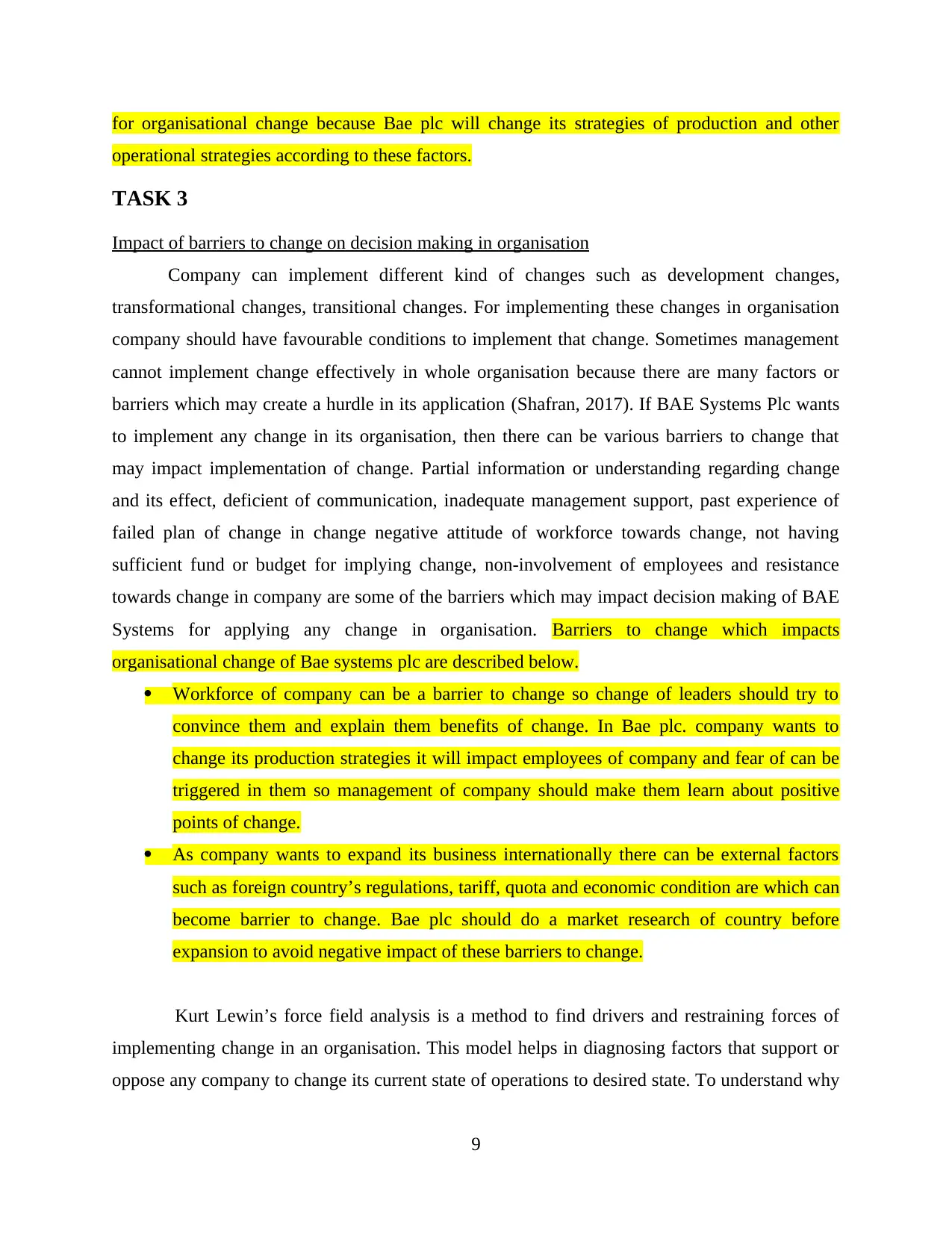
for organisational change because Bae plc will change its strategies of production and other
operational strategies according to these factors.
TASK 3
Impact of barriers to change on decision making in organisation
Company can implement different kind of changes such as development changes,
transformational changes, transitional changes. For implementing these changes in organisation
company should have favourable conditions to implement that change. Sometimes management
cannot implement change effectively in whole organisation because there are many factors or
barriers which may create a hurdle in its application (Shafran, 2017). If BAE Systems Plc wants
to implement any change in its organisation, then there can be various barriers to change that
may impact implementation of change. Partial information or understanding regarding change
and its effect, deficient of communication, inadequate management support, past experience of
failed plan of change in change negative attitude of workforce towards change, not having
sufficient fund or budget for implying change, non-involvement of employees and resistance
towards change in company are some of the barriers which may impact decision making of BAE
Systems for applying any change in organisation. Barriers to change which impacts
organisational change of Bae systems plc are described below.
Workforce of company can be a barrier to change so change of leaders should try to
convince them and explain them benefits of change. In Bae plc. company wants to
change its production strategies it will impact employees of company and fear of can be
triggered in them so management of company should make them learn about positive
points of change.
As company wants to expand its business internationally there can be external factors
such as foreign country’s regulations, tariff, quota and economic condition are which can
become barrier to change. Bae plc should do a market research of country before
expansion to avoid negative impact of these barriers to change.
Kurt Lewin’s force field analysis is a method to find drivers and restraining forces of
implementing change in an organisation. This model helps in diagnosing factors that support or
oppose any company to change its current state of operations to desired state. To understand why
9
operational strategies according to these factors.
TASK 3
Impact of barriers to change on decision making in organisation
Company can implement different kind of changes such as development changes,
transformational changes, transitional changes. For implementing these changes in organisation
company should have favourable conditions to implement that change. Sometimes management
cannot implement change effectively in whole organisation because there are many factors or
barriers which may create a hurdle in its application (Shafran, 2017). If BAE Systems Plc wants
to implement any change in its organisation, then there can be various barriers to change that
may impact implementation of change. Partial information or understanding regarding change
and its effect, deficient of communication, inadequate management support, past experience of
failed plan of change in change negative attitude of workforce towards change, not having
sufficient fund or budget for implying change, non-involvement of employees and resistance
towards change in company are some of the barriers which may impact decision making of BAE
Systems for applying any change in organisation. Barriers to change which impacts
organisational change of Bae systems plc are described below.
Workforce of company can be a barrier to change so change of leaders should try to
convince them and explain them benefits of change. In Bae plc. company wants to
change its production strategies it will impact employees of company and fear of can be
triggered in them so management of company should make them learn about positive
points of change.
As company wants to expand its business internationally there can be external factors
such as foreign country’s regulations, tariff, quota and economic condition are which can
become barrier to change. Bae plc should do a market research of country before
expansion to avoid negative impact of these barriers to change.
Kurt Lewin’s force field analysis is a method to find drivers and restraining forces of
implementing change in an organisation. This model helps in diagnosing factors that support or
oppose any company to change its current state of operations to desired state. To understand why
9
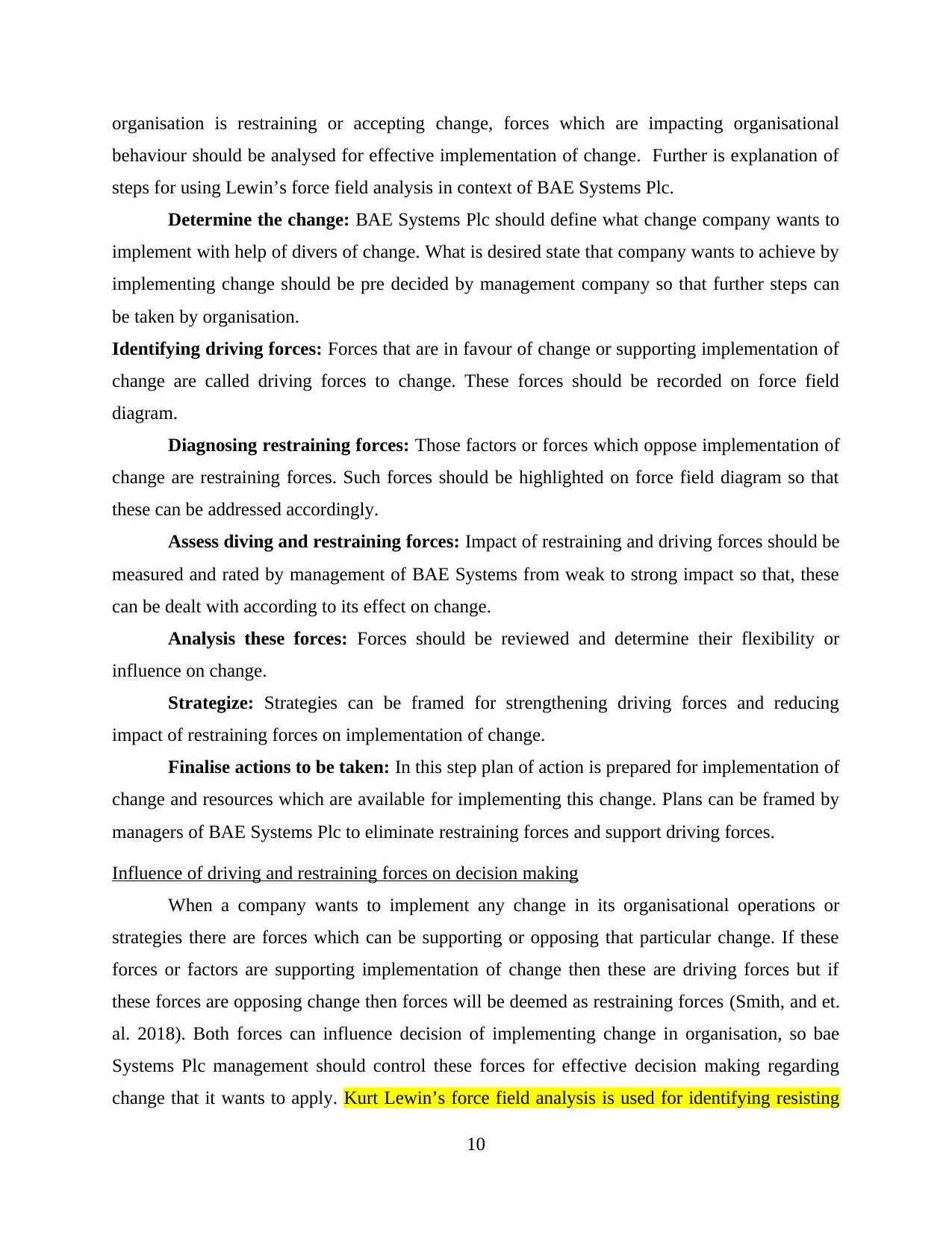
organisation is restraining or accepting change, forces which are impacting organisational
behaviour should be analysed for effective implementation of change. Further is explanation of
steps for using Lewin’s force field analysis in context of BAE Systems Plc.
Determine the change: BAE Systems Plc should define what change company wants to
implement with help of divers of change. What is desired state that company wants to achieve by
implementing change should be pre decided by management company so that further steps can
be taken by organisation.
Identifying driving forces: Forces that are in favour of change or supporting implementation of
change are called driving forces to change. These forces should be recorded on force field
diagram.
Diagnosing restraining forces: Those factors or forces which oppose implementation of
change are restraining forces. Such forces should be highlighted on force field diagram so that
these can be addressed accordingly.
Assess diving and restraining forces: Impact of restraining and driving forces should be
measured and rated by management of BAE Systems from weak to strong impact so that, these
can be dealt with according to its effect on change.
Analysis these forces: Forces should be reviewed and determine their flexibility or
influence on change.
Strategize: Strategies can be framed for strengthening driving forces and reducing
impact of restraining forces on implementation of change.
Finalise actions to be taken: In this step plan of action is prepared for implementation of
change and resources which are available for implementing this change. Plans can be framed by
managers of BAE Systems Plc to eliminate restraining forces and support driving forces.
Influence of driving and restraining forces on decision making
When a company wants to implement any change in its organisational operations or
strategies there are forces which can be supporting or opposing that particular change. If these
forces or factors are supporting implementation of change then these are driving forces but if
these forces are opposing change then forces will be deemed as restraining forces (Smith, and et.
al. 2018). Both forces can influence decision of implementing change in organisation, so bae
Systems Plc management should control these forces for effective decision making regarding
change that it wants to apply. Kurt Lewin’s force field analysis is used for identifying resisting
10
behaviour should be analysed for effective implementation of change. Further is explanation of
steps for using Lewin’s force field analysis in context of BAE Systems Plc.
Determine the change: BAE Systems Plc should define what change company wants to
implement with help of divers of change. What is desired state that company wants to achieve by
implementing change should be pre decided by management company so that further steps can
be taken by organisation.
Identifying driving forces: Forces that are in favour of change or supporting implementation of
change are called driving forces to change. These forces should be recorded on force field
diagram.
Diagnosing restraining forces: Those factors or forces which oppose implementation of
change are restraining forces. Such forces should be highlighted on force field diagram so that
these can be addressed accordingly.
Assess diving and restraining forces: Impact of restraining and driving forces should be
measured and rated by management of BAE Systems from weak to strong impact so that, these
can be dealt with according to its effect on change.
Analysis these forces: Forces should be reviewed and determine their flexibility or
influence on change.
Strategize: Strategies can be framed for strengthening driving forces and reducing
impact of restraining forces on implementation of change.
Finalise actions to be taken: In this step plan of action is prepared for implementation of
change and resources which are available for implementing this change. Plans can be framed by
managers of BAE Systems Plc to eliminate restraining forces and support driving forces.
Influence of driving and restraining forces on decision making
When a company wants to implement any change in its organisational operations or
strategies there are forces which can be supporting or opposing that particular change. If these
forces or factors are supporting implementation of change then these are driving forces but if
these forces are opposing change then forces will be deemed as restraining forces (Smith, and et.
al. 2018). Both forces can influence decision of implementing change in organisation, so bae
Systems Plc management should control these forces for effective decision making regarding
change that it wants to apply. Kurt Lewin’s force field analysis is used for identifying resisting
10
⊘ This is a preview!⊘
Do you want full access?
Subscribe today to unlock all pages.

Trusted by 1+ million students worldwide
1 out of 19
Related Documents
Your All-in-One AI-Powered Toolkit for Academic Success.
+13062052269
info@desklib.com
Available 24*7 on WhatsApp / Email
![[object Object]](/_next/static/media/star-bottom.7253800d.svg)
Unlock your academic potential
Copyright © 2020–2025 A2Z Services. All Rights Reserved. Developed and managed by ZUCOL.





